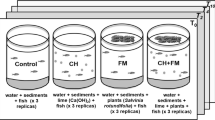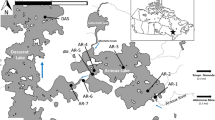Abstract
Calcium hydroxide (Ca(OH)2), or hydrated lime, has recently been reintroduced in western Canada as a treatment to reduce macrophytes and algae in eutrophic waters. We examined the effects and recovery of aquatic invertebrates of the Ca(OH)2 treatment (250 mg L−1) of one half of a divided eutrophic pond compared to the untreated half. Nine weeks following treatment, total invertebrates on the untreated side were present at 1917 ± 555 individuals m−2, and on the treated side at 822 ± 186 individuals m−2. Notably, Chironomidae represented 13% of invertebrates on the untreated half, but dominated numerically with 72% on the treated half of the pond. The remaining five most abundant taxa in the untreated side were 88%–99% less abundant in the treated half of the pond. Diversity and evenness were twice as high for the untreated half as for the treated half of the pond. Because macrophytes were also extirpated with the Ca(OH)2 treatment, macrophyteassociated taxa were absent or at low numbers in the treated half. The death of organisms on the treated side of the pond may have been caused (directly or indirectly) by the pH shock associated with Ca(OH)2 treatments. Slow recolonization by most invertebrates during the year of treatment was probably due to the lack of heterogeneous macrophyte habitat. Follow-up sampling 3 years later indicated that the pond completely regained the abundance and biological diversity of flora and fauna.
Similar content being viewed by others
References
Babin, J., E.E. Prepas and Y. Zhang, 1992. Application of lime and alum to stormwater retention lakes to improve water quality. Water Poll. Res. J. Chan. 27(2):365–381.
Babin, J., E.E. Prepas, T.P. Murphy, M. Serediak, P.J. Curtis, Y. Zhang and P.A. Chambers, 1994. Impact of lime on sediment phosphorus release in hardwater lakes: the case of hypereutrophic Halfmoon Lake, Alberta. Lake Reserv. Manage 8(2):131–142.
Bengtsson, B., W. Dickson and P. Nyberg, 1980. Liming acid lakes in Sweden. Ambio 9 (1):34–36.
Bryan, A.D., 1975. Experimental hydraulic dredging for aquatic weed control in Vernon Arm, Okanagan Lake, 1975. Pt VIII. Water Investigations Branch. British Columbia Ministry of the Environment. 158 pp.
Bulla, L., 1994. An index of evenness and its associated diversity measure. Oikos 70 (1):167–171.
Clifford, H.F., 1991. Aquatic Invertebrates of Alberta — An illustrated guide. The University of Alberta Press. Edmonton, Alberta. 538pp.
Driscoll, C.T., J.R. White, G.C. Schafran and J.D. Rendall, 1982. CaCO3 neutralization of acidified surface waters. J. Environ. Eng. 108:1128–1145.
Dvorak, J. and E.P.H. Best, 1982. Macro-invertebrate communities associated with the macrophytes of Lake Vechten: structural and functional relationships. Hydrobiologia 95:115–126.
Elser, M.M., J.J. Elser and S.R. Carpenter, 1986. Paul and Peter Lakes: a liming experiment revisited. Amer. Midl. Nat. 116:282–295.
Hasler, A.D., O.M. Brynildson and W.T. Helm, 1951. Improving conditions for fish in brownwater bog lakes by alkalization. J. Wildl. Manage. 15(4):347–352.
Hilsenhoff, W.L., 1991. Diversity and classification of insects and collembola. In: J.H. Thorp and A.P. Covich (eds.), Ecology and classification of North American freshwater invertebrates. Academic Press, Inc. Toronto, Canada pp.593–663.
Kretser, W.A. and J.R. Colquhoun, 1984. Treatment of New York's Adirondack lakes by liming. Fisheries 9:36–41.
Minshall, G.W., 1984. Aquatic insect-substratum relationships. In: V.H., Resh and D.M. Rosenberg (eds.), The Ecology of Aquatic Insects. Praeger, New York, pp. 358–400.
Murphy, K.J. and J.W. Eaton, 1981. Ecological effects of four herbicides and two mechanical clearance methods used for aquatic weed control in canals. Association of Applied Biologists, Proc. Aquat. Weeds and their Control. pp.201–217.
Murphy, T.P. and E.E. Prepas, 1990. Lime treatment of hardwater lakes to reduce eutrophication. Verh. Internat. Verein Limnol. 24:327–334.
Murphy, T., E. Prepas, J. Babin, K. Hall and P. Manning, 1993. Developments in lake restoration in western Canada. Can. Water Resources J. 18 (3):299–305.
Murphy, T.P., E.E. Prepas, J.T. Lim, J.M. Crosby and D.T. Walty, 1990. Evaluation of calcium carbonate and calcium hydroxide treatments of prairie drinking water dugouts. Lake Reserv. Manage. 6(1):101–108.
Newbold, C., 1981. The decline of aquatic plants and associated wetland wildlife in Britain – Causes and perspectives on management techniques. Association of Applied Biologists, Proc. Aquat. Weeds and their Control. pp. 241–251.
Pennak, R.W., 1978. Fresh-water invertebrates of the United States. John Wiley & Sons, Inc., Toronto, Canada. 803 pp.
Prepas, E.E., T.P. Murphy, J.M. Crosby, D.T. Walty, J.T. Lim, J. Babin and P.A. Chambers, 1990. Reduction of phosphorus and chlorophylla concentrations following CaCO3 and Ca(OH)2 additions to hypereutrophic Figure Eight Lake, Alberta. Environ. Sci. Technol. 24 (8):1252–1258.
Prepas, E.E., D.T. Walty, T.P. Murphy, J.M. Babin and P.A. Chambers, 1992. Management of farm dugouts as water supplies; use of lime for algal and macrophyte control. Project #89-0462. Farming for the Future. Alberta Agriculture. 65 pp, plus 99 pp in Appendices.
Scheider, W. and T.G. Brydges, 1984. Whole-lake neutralization experiments in Ontario: a review. Fisheries 9:17–18.
Scheider, W. and P.J. Dillon, 1976. Neutralization and fertilization of acidified lakes near Sudbury, Ontario. Water Pollut. Res. Can. 11:93–100.
Schramm, H.L., K.J. Jirka and M.V. Hoyer, 1987. Epiphytic macroinvertebrates on dominant macrophytes in two central Florida lakes. J. Freshw. Ecol. 4 (2):151–161.
Snyder, M.R., 1990. The effect of calcium hydroxide on the benthic invertebrate population in a TreflanTM treated dugout. Unpublished MS. University of Alberta. Edmonton.
Ward, J.V., 1992. Aquatic Insect Ecology — 1. Biology and Habitat, John Wiley and Sons, Inc. Toronto, 437 pp.
Washington, H.G., 1984. Diversity, biotic and similarity indices. A review with special relevance to aquatic ecosystems. Water Res. 18(6):653–964.
Weatherley, N.S., 1988. Liming to mitigate acidification in freshwater ecosystems: a review of the biological consequences. Water Air Soil Pollut. 39:421–437.
Author information
Authors and Affiliations
Rights and permissions
About this article
Cite this article
Miskimmin, B.M., Donahue, W.F. & Watson, D. Invertebrate community response to experimental lime (Ca(OH)2) treatment of an eutrophic pond. Aquatic Science 57, 20–30 (1995). https://doi.org/10.1007/BF00878024
Received:
Accepted:
Issue Date:
DOI: https://doi.org/10.1007/BF00878024




